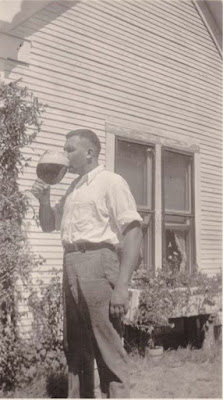Robert E. Howard’s Conan the Cimmerian
wandered into the pages of Weird Tales with
“The Phoenix on the Sword” (Dec 1932), and was followed by “The Scarlet
Citadel” (Jan 1933), “The Tower of the Elephant” (Mar), “Black Colossus” (Jun),
“The Slithering Shadow” (Sep), “The Pool of the Black One” (Oct), "Rogues
in the House" (Jan 1934), "Shadows in the Moonlight" (Apr),
"Queen of the Black Coast" (May), "The Haunter of the Ring"
(Jun), "The Devil in Iron" (Aug), and the serial "The People of
the Black Circle" (Sep-Oct-Nov). Much of the response in “The Eyrie,” the
letters-column of Weird Tales, was
positive...but in the November 1934 issue there was a letter aimed at the popular
series character:
A Crack At Conan
Conan
is rapidly becoming a stereotyped hero, but I was greatly pleased with Francis
Flagg, a real writer, with something to say. I am awfully tired of poor old
Conan the Cluck, who for the past fifteen issues has every month slain a new
wizard, tackled a new monster, come to a violent sudden end that was averted
(incredibly enough!) in just the nick of time, and won a new girlfriend, each
of whose penchant for nudism won her a place of honor, either on the cover or
on the inner illustration. Such has been Conan’s history, and from the realms
of the Kushites to the lands of Aquilonia, from the shores of the Shemites to
the palaces of Dyme-Novell-Bolonia, I cry: “Enough of this brute and his
iron-thewed sword-thrusts-may he be sent to Valhalla to cut out paper dolls.” I
would like to see the above tirade in print—I feel sure that many of your other
readers would support me—at least there is good material there for an
arguement. [Sharpen your axes, you loyal supporters of the Conan tales, for
soon we shall publish a short story by Mr. Bloch, the author of the above
letter. It is entitled The Secret in the
Tomb.—The Editor.]
 |
| Robert Bloch |
The writer was Robert Bloch, a teenaged fan
who was, by coincidence, just about to make his professional debut in Weird Tales. Bloch had begun
corresponding with H. P. Lovecraft in 1933 (LRB
9), and as was quite natural for Lovecraft, he shared his thoughts on
Robert E. Howard:
Robert
E. Howard is a most unusual character—the son of a physician in the wild &
woolly, rip-roaring West Texas country, which is actually much more like the sanguinary West of chap
fiction than we commonly realise. Howard is 27, & is probably the greatest
living authority on the history & traditions of the Southwest, & the
lives of America’s noted outlaws. He is a burly, athletic chap fonder of
fighting than of literature, & possessed of the curious belief that
primitive barbarism is a more desirable sort of social organisation than
civilisation. His letters have a greater literary value than his tales. (LRB 23)
You
are also right in assuming that Robert E. Howard has never been to Britain. So
far as I know, he has never been east of New Orleans—but his imagination is
limitless, & he closely identified himself with his Celtic & Norse
ancestors. As for his incessant swordplay—which Clark Ashton Smith calls
“monotonous manslaughter”—that is undoubtedly an outgrowth of the same frontier
psychology which makes him so fond of barbaric life. It is a part of his
personality, & I don’t suppose it could be eradicated without upsetting the
whole emotional arrangement which makes him a literary creator. He has a very
vivid sense of incredible antiquity,
& finely suggests the existence of unhallowed elder worlds & forgotten
reaches of time. (LRB 28)
Although
Lovecraft credited Smith with describing the Conan tales as “monotonous
manslaughter,” the phrase is not apparent in Smith’s published letters and may
have arisen from Lovecraft himself. Bloch was generally appreciative of
Howard’s fiction, a letter to “The Eyrie” published in the April 1934 issue
praised “The Valley of the Worm,” though he derided Conan, writing:




